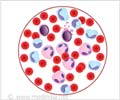Donor transplants that effectively reboot immune defenses is a way of treating patients with advanced chronic lymphocytic leukemia (CLL).

Now, scientists at Dana-Farber Cancer Institute report in the Journal of Clinical Investigation that they observed a strong and selective immune response in some patients who received, shortly after the transplant, several doses of a "personalized" tumor vaccine composed of their own inactivated leukemia cells combined with an immune stimulant, GM-CSF. Thus the vaccine boosted the power of the transplanted immune system's ability to attack the cancer – known as the graft-versus-leukemia (GvL) effect.
"Our studies suggest that autologous tumor cell vaccination is an effective strategy to advance long-term leukemia control" following transplants from donors, said Catherine Wu, MD, senior author. "Although this was a phase 1 study and not powered to look at questions of clinical efficacy, we did see promising clinical activity."
There are few treatment options for advanced CLL. Standard transplants, which involve powerful doses of pre-transplant chemotherapy to wipe out as much of the leukemia as possible, have proven too toxic for older patients and those with co-existing diseases. Over the past decade, researchers have developed reduced-intensity conditioning (RIC) regimens, using lower chemotherapy doses that are more tolerable but which rely entirely on the activity of the transplanted immune cells to battle the leukemia. Usually this is insufficient to keep the cancer at bay long-term and the disease progresses.
Furthermore, research has shown that the identifying antigens on the surface of CLL cells in individual patients may differ – that is, they have "personal tumor antigens," the scientists said. "Based on these principles, vaccination with autologous [the patient's own stored leukemia cells] irradiated leukemia cells is an attractive approach to expand leukemia-reactive T cells, since this vaccine formulation reliably includes personal tumor antigens."
To make the vaccine, the researchers mixed the patients' irradiated leukemia cells with cells that produce GM-CSF (granulocyte-macrophage colony-stimulating factor) and then injected them back into the patient. The combination stirs up a strong response by immune T cells, and the distinctive antigens on the injected leukemia cells direct the T cells to attack similar leukemia cells wherever they are present in the body.
Advertisement
Four patients did not receive the vaccine because they developed GVHD following the transplant. The remaining 18 received at least one vaccine dose; seven patients stopped receiving the vaccine after they developed GVHD.
Advertisement
The results support the safety and biological activity of whole tumor-cell vaccination in hematological malignancies, said the authors, and that giving the vaccine shortly after transplant may have been critical in its effectiveness. In addition, they said a key to the vaccine's potency was the development by Dana-Farber scientists of GM-CSF-secreting "bystander" cells that can be used against lymphoid malignancies – which was not possible previously.
However, the authors noted that further randomized studies in larger patient groups will be necessary to determine if this strategy "will translate into a true clinical benefit for patients with advanced CLL."
Source-Eurekalert














